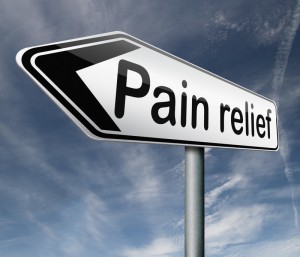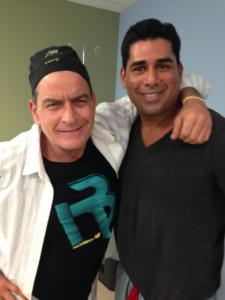Stem Cell Procedures
FAQs on Amniotic and Bone Marrow Derived Stem Cell Procedures
Dr. Raj and Charlie Sheen discuss stem cell therapy!
Why are Stem Cells so revolutionary?
Stem cells have been a breakthrough in orthopedic and sports medicine for two simple reasons. They can turn into all types of cells necessary for healing sports injuries and degenerative conditions such as arthritis. And second, they have the ability to heal injury, not just cover up pain like a steroid injection.
The latest stem cell treatments do not involve fetal tissue at all, which has removed any ethical concerns. They are all performed as an outpatient, with small studies to date showing amazing results for all types of injury such as rotator cuff injuries, sports injuries, tendonitis, arthritis and more.
What is the normal treatment for osteoarthritis and sports injuries?
Osteoarthritis is treated with a combination of treatment interventions. Initial management with conservative options is always preferred. This includes physical therapy and rehabilitation to improve the strength and conditioning of the supporting joints, weight loss, lifestyle modifications to reduce the stress on the joint, and medications. In particular, analgesic medications such as non-steroidal anti-inflammatory drugs (NSAIDs) and Tylenol are used to provide relief of symptoms.
Additional treatment options include bracing, topical pain medications, cane, hyaluronic acid injections or steroid injections.
If conservative options fail, then surgery may be considered. A complete or partial arthroplasty (joint replacement surgery) may be considered.
Sports injuries often involve physical therapy, steroid injections, ultrasound, electrical stimulation and more. Most treatments to date have not been able to assist in the healing much, just offer pain relief.
Why are stem cells used?
There have been promising studies that have demonstrated the potential of stem cell therapy in the treatment of degenerative conditions such as osteoarthritis, sports injuries, tendonitis and ligament injury as well. Stem cells have the ability to develop into different types of tissues, which can be important in repairing the damaged areas of the joint. Other studies have shown that stem cells not only promote growth and healing, but they also stimulate the release of repair and growth factors. Stem cells can be harvested from various sources, such as the bone marrow, amniotic membrane, and fatty tissues.
Stem cells have the ability to turn into cartilage, tendon, bone and ligament cells. This is why they have been so revolutionary for healing all types of musculoskeletal injuries.
How are bone marrow-derived stem cells used for musculoskeletal injuries?
Mesenchymal stem cells, which have pluripotent growth, are harvested from the patient’s own bone marrow. This reduces the possibility of immune rejection and circumvents ethical issues from harvesting stem cells. These stem cells are derived from the patient and concentrated through laboratory procedures.
These mesenchymal stem cells are then immediately processed to concentrate the cells and injected into the target area such as the arthritic joint, tendon or damaged ligament. All types of sports injuries benefit from the stem cell treatments.
How are amniotic-derived stem cells used?
Amniotic derived stem cells are obtained from consenting donors undergoing a scheduled c-section. Normally the amniotic fluid is discarded, so there are no ethical concerns especially since the fetus is not harmed in any way.
Amniotic fluid obtains a very high concentration of stem cells, growth factors, hyaluronic acid and antimicrobial properties. All of these help with pain relief and joint regeneration. There is no rejection reaction from one’s body since the fluid is “immunoprivileged”. The fluid is processed at an FDA regulated laboratory and has been used over 10,000 times across the country with no adverse events reported to date.
The amniotic derived stem cells are used successfully for all types of musculoskeletal injury such as joint arthritis, rotator cuff injury or tendonitis of the elbow, ankle knee and hip. Athletes benefit by often avoiding surgery and getting back on the field faster than with surgery. Patients who are facing joint replacement are often able to avoid or delay the need for it.
What are the results of stem cell therapy for osteoarthritis?
 There are still no large-scale studies, but initial trials with stem cell therapy are promising. Patients who received stem cell therapy reported greater pain relief than the control group, even with similar baselines for pain. Complications were not noted, and no ectopic tissue was noted to grow. Larger clinical trials are still needed to make a definitive pronouncement on the effectiveness of stem cell therapy.
There are still no large-scale studies, but initial trials with stem cell therapy are promising. Patients who received stem cell therapy reported greater pain relief than the control group, even with similar baselines for pain. Complications were not noted, and no ectopic tissue was noted to grow. Larger clinical trials are still needed to make a definitive pronouncement on the effectiveness of stem cell therapy.
Currently, Beverly Hills Orthopedic Institute is at the forefront of stem cell therapy. Dr. Raj provides both amniotic derived stem cells and bone marrow derived stem cells for tendonitis, ligament injuries and degenerative arthritis. The stem cell procedures have been a “game changer” for orthopedic medicine. Dr. Raj performs the procedure on athletes, celebrities, executives, grandparents, manual laborers, weekend warriors and more.
To schedule for an evaluation to discuss how stem cell therapy can help your arthritis or soft tissue injury, call (310) 247-0466 today!
References
Diekman BO, Guilak F. Stem cell-based therapies for osteoarthritis: challenges and opportunities. Curr Opin Rheumatol. 2013 Jan;25(1):119-26. doi: 10.1097/BOR.0b013e32835aa28d.
Jo CH, Lee YG, Shin WH, et al. Intra-Articular Injection of Mesenchymal Stem Cells for the Treatment of Osteoarthritis of the Knee: A Proof-of-Concept Clinical Trial. Stem Cells. 2014 May;32(5):1254-66. doi: 10.1002/stem.1634.
Keerthi N, Chimutengwende-Gordon M, Sanghani A, Khan W. The potential of stem cell therapy for osteoarthritis and rheumatoid arthritis. Curr Stem Cell Res Ther. 2013 Nov;8(6):444-50.

